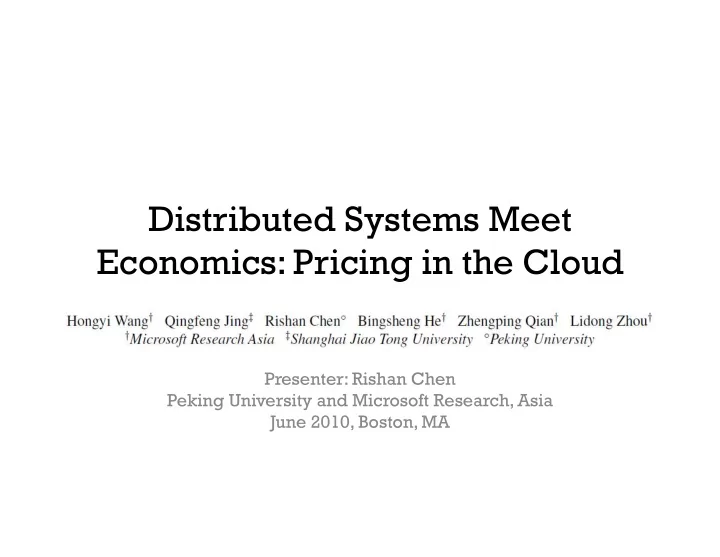

Distributed Systems Meet Economics: Pricing in the Cloud Presenter: Rishan Chen Peking University and Microsoft Research, Asia June 2010, Boston, MA
Cloud is a distributed system • System metrics – Throughput – Latency / response time – Failure rate – Power consumption, etc. • As a pay-as-you-go service – Two parties connected by the pricing scheme – It’s all about the money! 2
Pricing in the Cloud • It significantly changes the landscape of system design: Cost as an explicit and measurable system metric – How both parties optimize their logic – Is the pricing fair – How does the pricing interplay with the evolving system dynamics – How to measure the cost of failures, etc. 3
Methodology overview • Approximate a typical workload in current cloud computing • Postmark (I/O-intensive) • PARSEC : Dedup , BlackScholes (CPU-intensive) • Hadoop (large-scale data processing) • Complementary approaches for evaluations • A black-box approach with Amazon EC2 • Built a cloud-computing test bed, Spring , to perform fully controlled experiments 4
Preliminary results • Pricing may give different indices for users and providers for system optimizations ( e.g. , consolidation) • System performance variations may lead to pricing fairness issues • System evolution ( e.g. , adoption of new hardware like SSD ) may affect pricing scheme • Failures need to be better dealt with regarding to the cost 5
Highlights of our study /1 • Pricing (profit) versus throughput Run Postmark continuously and report the number for four tasks; we compare the consolidation of x VMs on a single physical machine. 6
Highlights of our study /2 • Optimizing for cost versus optimizing traditional system metrics 1 1.2 Postmark User Index (1/Cost) 1 0.8 Provider Index User Index 0.8 Provider Index (ROI) 0.6 0.6 0.4 0.4 0.2 0.2 0 0 -0.2 7
Highlights of our study /3 • Pricing fairness: performance variation 8
Open questions • What are good properties for a pricing scheme? • How do users and providers adapt the system design to evolving and even hybrid pricing schemes? • How is the pricing scheme adapted to the evolving system dynamics and (new) technologies? • How to deal with failures’ cost regarding to the pricing? 9
Related work • Other pricing schemes – Bilateral – Amazon EC2 Spot Instances: Enable you to bid for unused Amazon EC2 capacity • Navraj Chohan, et al., See Spot Run: Using Spot Instances for MapReduce Workflows , June 2010 – Microsoft SQL Azure: Make pricing more scalable and more predictable • Distributed computing w/ Economics – Jim Gray, Distributed Computing Economics , March 2003 – Ang Li, et al., CloudCmp: Shopping for a Cloud Made Easy , June 2010 10
Summary • Pricing is an important bridge between users and providers • It significantly changes the dynamics in system design • The interplay between economics and system design can be a fruitful research direction 11
Recommend
More recommend